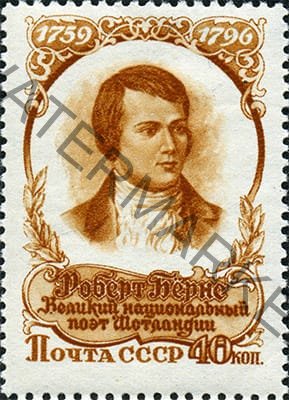2K
Robert Burns (1759-1796), known as “Rabbie Burns,” is Scotland’s national poet. Born in Alloway, Ayrshire, Burns lived a life that intertwined with the struggles of his time.
Raised in a humble farming family, rural Scotland’s traditions shaped Burns’s early years, which he celebrated in his works. Burns’s poetry resonates with themes of love, nature, and social justice, earning him recognition in Scotland and globally.

Despite his short life, Burns left an indelible mark on Scottish culture. After taking up the pen to write about his life experiences, his poetry gained widespread popularity. His works gave voice to the poor and working-class Scots, reflecting their joys, challenges, and aspirations. Many of Burns’s writings still speak to contemporary social issues, highlighting his timeless appeal.
Burns’s literary output is vast, but certain works stand out. These include:
Auld Lang Syne – Perhaps his most famous work, often sung at New Year’s Eve celebrations across the globe.
Address to a Haggis – A poem paying tribute to Scotland’s national dish, often recited during Burns Night celebrations.
To a Mouse – A poignant poem reflecting on the human condition, it explores the fragility of life and our relationship with nature.
In addition to his poetry, Burns had a practical side: he worked as an exciseman (a tax collector) for the British government. This role involved inspecting and enforcing taxes on whisky, and Burns’s time as an exciseman was not without controversy. His knowledge of the rural communities he served made him aware of the struggles faced by ordinary people. This experience found its way into his poems, often criticising the class system and societal injustices.
Robert Burns’s poetry transcended national borders and continues to have a global impact. His works have been translated into numerous languages, and his poems resonate with audiences around the world. Burns’s commitment to equality, freedom, and social justice has made his work not only significant in Scotland, but also relevant to international audiences who identify with his messages.
One of the most striking symbols of Burns’s global legacy is the many statues dedicated to him worldwide. From Edinburgh to New York, from Toronto to Sydney, Burns’s statues are enduring tributes to his influence. These statues serve as reminders of his literary contributions and the universal themes he championed. Notable monuments include the Robert Burns Monument in Edinburgh, the Burns Memorial in Dumfries, and the Burns Statue in Central Park, New York, among many others.
Burns’s fame was so widespread that it even reached the world of philately. In 1959, Russia issued a stamp to commemorate the 200th anniversary of Robert Burns’s birth, making them the first country to honour him in this way. The stamp featured a portrait of Burns and marked a key moment in his global recognition.

The UK, however, followed suit a decade later, issuing its commemorative stamp in 1969, marking the 210th anniversary of Burns’s birth. Although Scotland was Burns’s birthplace, it was Russia that first honoured him with a stamp, reflecting how Burns’s influence stretched far beyond the borders of Scotland and Britain.
For those interested in learning more, visiting key locations tied to Burns’s life is a perfect way to connect with his legacy. Some notable sites include:
Robert Burns World Federation promotes and celebrates the life and works of Robert Burns and Scotland’s heritage, language, and culture.
Alamo Burns Club – Paisley
Alexandria Burns Club – Founded 1884.
Bridgeton Burns Club – Founded in 1870.
Dalry Burns Club – the longest, continuous record of anniversary dinners in the world.
Dumbarton Burns Club – “On the evening of 25th January 1859 a party of 26 admirers of our national bard sat down to dinner in the Elephant Hotel, High Street, Dumbarton : and so began Dumbarton Burns Club.”
The Burns Howff Club – formed in the Globe Inn, Dumfries, south-west Scotland in 1889, and meets on the 25th January each year to celebrate the anniversary of the birth of Robert Burns in 1759 with a “Burns Supper”.
Greenock Burns Club – Instituted in 1801, it is the oldest Burns Club in the world and is known as “The Mother Club” – Greenock Burns Club on Facebook
Irvine Burns Club – The club has an unbroken history dating back to its formation on 2nd June 1826. Of the twelve founding members of the club five were known to Robert Burns, two of whom were close friends of the poet.
Paisley Burns Club – Founded on 29th January 1805.
Perth Burns Club – instituted on 8th February 1873.
Robert Burns Association of North America – RBANA is an association dedicated to the preservation and appreciation of the life, works and philosophy of Robert Burns, Scotland’s National Bard.
Calgary Burns Club – fosters an interest in Scottish literature, art and music by sharing its talents with the community and through support of events involving Scottish cultural activities.
Halifax Burns Club – “Our organization is based on the Tarbolton Bachelors’ Club founded by Burns. Like the original club, we seek to be “a diversion for the weary man worn down by necessary labours of life””
Medicine Hat Burns Club – Established in 2008
Robert Burns Society of the Midlands – Columbia, South Carolina
Robert Burns – by The BBC
Robert Burns – by the Gazetteer for Scotland
Robert Burns – by The National Library of Scotland